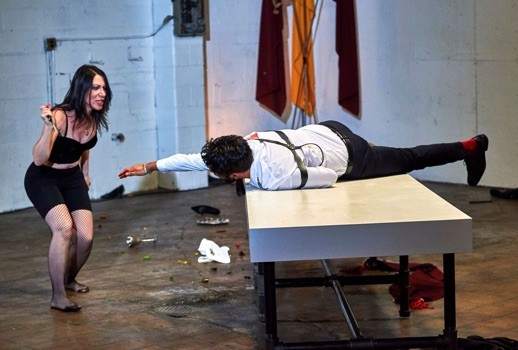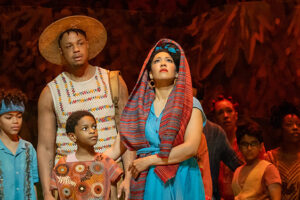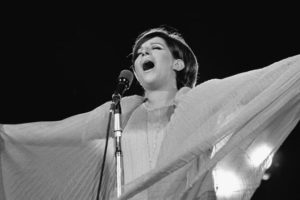

And yet, I write this with a touch of reluctance, because to claim LoftOpera’s production an unqualified success would be an overstatement. The orchestra failed to coalesce into an ensemble, and the tenor was often flat; but, these defects were elided by the sheer vocal power of Eleni Calenos, the opera’s titular prima donna, as well as the subtly conservative ƒaaging from its director, Raymond Zilberberg.
LoftOpera is known for its unconventional, site-specific performances—where every time a beer bottle falls over, an opera queen gets her crown. This Tosca is no exception: it’s staged in an old bus depot. Entering into the cavernous performance space felt a little like stepping onto the set of Saw, but the overall laid-back atmosphere and amicable mingling of audience and cast made for a relaxing ambience.
The event, located in Bushwick, definitely had a streak of youthful defiance woven into the scenery. But, while I’m typically skeptical of any project that endeavors to rebrand opera as “hip,” “cool,” and “with it” (the art form needn’t apologize for itself), LoftOpera’s mission seems to be more about being unbuttoned, communal, and welcoming; which, for sure, offers a healthy antidote to the pretensions of Lincoln Center.
Ultimately, my only complaint regarding this unconventionality was that the audience sat on benches instead of actual chairs: very uncomfortable, and resulting in uncalled for invasions of personal space, as well as some distracting seat squirming for the long duration of the show.
When Calenos strutted into Zilberberg’s mise-en-scène, looking sophisticated in sunglasses and a sunhat, her presence kicked the proceedings into high gear, galvanized the space, and pricked the heart. Which is to say, her singing was some of the best I’ve heard in a long time—especially her middle register, which managed to be juicy, sonorous, and elegantly phrased all at once.

Unfortunately, the lovers were not well paired. As Cavaradossi, James Chamberlain seemed overparted, lacking both a compelling stage presence and a reliable voice. He had a tendency to go flat, and was audibly strained during certain phrases above the passaggio. To his credit, he had the fresh face of an ideological painter, and physically, he suited the role well.
As his nemesis Scarpia, Gustavo Feulien provided a welcomed dose of sexy danger. Dressed like a Brooklyn-hipster-turned-chief-of-police(?), Feulien frankly looked and acted like a movie star (let’s just say that if I were Tosca the opera would’ve ended very differently). Unfortunately, his singing didn’t always quite match the dazzle of his form. He had a tendency to bellow at certain key moments of dramatic intensity, which, while understandable in terms of stagecraft and storytelling, was ultimately unsatisfying.
The remaining ensemble proved adequate, though largely inconspicuous. Joseph Beutel was a rather generic Angelotti, though the functional role rarely gave him an opportunity to make much of an impression. And Stephanos Koroneos proved an inoffensive Sacristan, despite his tendency to rely on parlor tricks for laughs. However, a special mention should be made for Jordan Pitts: he had a clear, ringing tenor, unfortunately underutilized in the role of Spoletta. The chorus, managing a rich, layered sound, boisterously supported this ensemble.
The direction by Raymond Zilberberg was generally (and thankfully) concept-less, despite the contemporary dress and setting. Stripped bare, Zilberberg’s sensitivity allowed the music and text to speak for itself—a breath of fresh air in a climate of over-produced, over-conceptualized, and over-curated performing arts.

Tosca’s murder of Scarpia was a noteworthy highlight in the second act—well acted, especially, by Feulien; the liberal use of fake blood evoked the true gore of the subject matter. On the other hand, Tosca performed the famous “Vissi d’arte” while standing on a table—an odd choice that seemed out of place in this context.
In contrast to the efficient staging, maestro Dean Buck’s conducting of the orchestra resulted in this Tosca’s major drawback. The orchestra, diminished in order to accommodate special limitations, often dragged in tempo, veered unpleasantly out of tune, and failed to remain sensitive to the needs of the singers. For example, the orchestra overpowered Feulien during the Te deum that ends Act I. Fortunately, such incompetence still failed to diminish the genius of Puccini’s score.
LoftOpera offers a creative, sustainable model for how to produce opera, one that suggests a whole host of possibilities for the form. Such reinvention of old ideas is cause for excitement, an acute sense of renaissance. For example, much of the evening reminded me of the spirited ethos of 1960s off-off-broadway theater, a widely documented matrix of extreme creativity, experimentation, and revolution.
Like the nostalgically celebrated houses of the avant-garde (think La MaMa, Judson Poet’s Theater, and Caffe Cino), LoftOpera’s production of Tosca represents a kind of return to opera’s core values—text and drama—as well as a fun leap forward. Relying heavily on the true building blocks of the form, the company manages to be creative and inventive, while remaining well-tethered, albeit subtly, to its origins.
Photos: Robert Altman























Comments